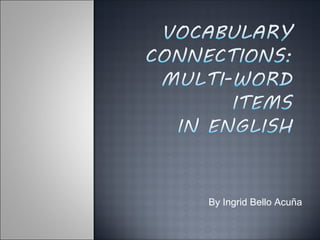
Vocabularyconnections
- 1. By Ingrid Bello Acuña
- 2. It is natural to focus on the word as the primary unit. Dictionaries reinforce this idea by representing the lexicon. The lexicon is a series of headwords or individual lexical items.
- 3. Models of language are built on grammatical principles, with the clause or sentence being the focal unit. Connections are the syntactic relationships between elements in the clause or sentence. Open choice principle: it is a way of seeing language text as the result of a very large number of complex choices. A unit is completed- a word or a phrase or a clause- a large range of choice opens up. (traditional approach to language) Idiom principle: it is that a language user has available to him or her a large number of semi- preconstructed phrases that constitute single choices(it could be analyse into segments)
- 4. “As a syntactic view of language observes rules undepinning grammatically well-formed utterances, a collocationist view of language observes the strong patterning in the co-occurrence of words”. “This kind of approach is proposed by psycholinguistics, which observes how language is processed and often acquired in chunks or groups of words, rather than on word-by-word basis”. “Vocabulary is not operate as independent and interchangeable parts of the lexicon, but as parts of a lexical system”. Peters (1983) “Restricted collocations are cases where certain words occur almost in the co-text of one or two other words, or of a narrow set of words”.
- 5. There are many different forms of multi-word item, and fields of lexicology and idiomatology have generated an unruly collections of nmes for them. Multi-word item: it is a vocabulary item which consists of a sequence of two or more words and also multi-words items are the result of lexical (and semantic) processes of fossilisation and word-formation.
- 6. Institutionalisation: is the degree to which a multi-word item is conventionalised in the language. Fixedness: is the degree to which a multi-word item is frozen as a sequence of words. Non- compositionality: is the degree to which a multi- word item cannot be interpreted on a word-by-word basis, but has a specialised unitary meaning . “ the criteria operate together and they are not absolutes but variables, and they are present in different types of multi-word item
- 7. Compounds: they may differ from single words only by being written as two or more orthopraphic words. They cannot properly be separated out altogether, since variable hyphenation conventions blur the distinction between compoun multi-word items and polymorphemic single words. E.g car park which is spelled carpark and car- park “ Many open or two-word compounds are nouns” e.g Prime minister Phrasal verbs: are combinations of verbs and adverbial or prepositional particles. They are typically a phenomenon of English and a few cognate languages for example Dutch.Moreover, they have specialised meanings.
- 8. Idioms: it is a variety of different meanings. They have holistic meanings which cannot be retrieved from the individual meanings of the component words. Idioms are typically metaphorical in historical or etymological terms. e.g spill the beans, kick the bucket and so on Fixed phrases: they include items such as of course, at least, in fact, and by far as weell as greetings and phatics such as good morning, how do you do, excuse me, and you know. Prefabs: they are referred to as “ lexicalised sentence stems” or “ ready- made units” and call them “ lexical phrases”. Prefabs are preconstructed phrases, phraseological chunks, stereotyped collocations, or semifixed strings which are tied to discoursal siuations and which form structuring devices.
- 9. Semantics- based models are in many respects the most traditional. They attempt to differentiate between caterogaries of multi-word items according to degress of compositionality, and they aim to identify, as it were, the irreducible semantic building-blocks of the lexicon. Syntax- based models take grammatical well- formedness as their starting-point. Multi words items- and in particular idioms and fixed phrases- are not often non-compositional because they do not obey rules.
- 10. The principal kinds of variation - British/ American variations: hold the ford (Bre) hold down the fort ( Ame) - varying lexical component: burn your boats/bridges - unstable verbs: show/declare/reveal your true colours - transformation: break the ice/ice- breaker/ice-breaking - truncation: silver lining/every cloud has a silver lining
- 11. Multi-word items are typically presented as a problem in teaching and learning a foreign language. Their non- compositionality, whether syntactic, semantic or pragmatic in nature, means that they must be recognised, learned, decoded and encoded as holistic units. Teachers and learners can avoid the problem by avoiding such items altogether, and in many cases this can be justified because of the relative infrequency of ocurrence of many kinds of multi-word item
- 12. The most appropiate strategy for teaching them is the use of short dialogues.At more advanced levels the use of contextualised examples would show up discoursal features. Irujo suggests that multi- word items to be taught should be carefully chosen on the basis frequency, need, transparency and syntactic and semantic simplicity. The most innovative pedagogical studies highligh and focus on the importance of multi-word item as enabling devices. Improved information about the nature and function of multi-word items will mean that they are understood, taugh and produced more competently and effectively.